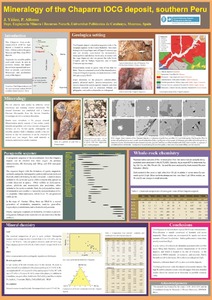Mostra el registre d'ítem simple
Mineralogy of the Chaparra IOCG deposit, southern Peru
| dc.contributor.author | Yáñez González, Juan Alberto |
| dc.contributor.author | Alfonso Abella, María Pura |
| dc.contributor.other | Universitat Politècnica de Catalunya. Departament d'Enginyeria Minera, Industrial i TIC |
| dc.contributor.other | Mineria per al Desenvolupament |
| dc.contributor.other | Universitat Politècnica de Catalunya. Centre de Cooperació per al Desenvolupament |
| dc.coverage.spatial | east=-73.86361062526703; north=-15.73981699858832; name=Caravelí Province, Perú |
| dc.date.accessioned | 2018-04-25T12:09:43Z |
| dc.date.available | 2018-04-25T12:09:43Z |
| dc.date.issued | 2014 |
| dc.identifier.citation | Yáñez, J., Alfonso, P. Mineralogy of the Chaparra IOCG deposit, southern Peru. A: European Geosciences Union General Assembly. "Geophysical research abstracts, 2014, vol. 16, EGU2014-15675". European Geosciences Union (EGU), 2014. |
| dc.identifier.isbn | 1607-7962 |
| dc.identifier.uri | http://hdl.handle.net/2117/116680 |
| dc.description.abstract | The Chaparra IOCG, located in southern Peru, near Chala, is mined and exploited by small-scale miners for gold, however, it has not been studied until now. Here we present a preliminary geological and mineralogic study of this deposit. Powder X ray diffraction, electron microscopy and electron microprobe were used to characterize the mineralization. This deposit is hosted in magmatic rocks from the Coastal Batholith. Host rocks belong to the Linga Super-unit, of Upper Cretaceous age and are mainly constituted by monzonites, monzogabbros and diorites. Major alterations are the propylitic (chlorite - albite - quartz), advanced argillic (jarosite - natrojarosite) and sericitic (muscovite-sericite-quartz). Gypsum and other alteration minerals such as potassium feldspar and phlogopite, vermiculite and natrolite are widespread. Mineralization occurs mainly in quartz veins up to 1 m thick, emplaced filling fractures. Ore mineralogy is mainly composed of hematite, goethite, and sulphides (mainly pyrite, chalcopyrite and covellite). Gold and REE-rich minerals also occur. Native gold can reach up to 1 mm in size, but usually is few m in size. Its composition is 82-92 wt% Au, up to 12 wt% of Ag and Fe can reach up to 4 wt%. The paragenetic sequence in the Chaparra deposit was divided into three stages: (I) primary mineralization, (II) Fracture filling, and (III) supergene alteration. The sequence begins with the crystallization of magnetite, quartz, pyrrhotite and pyrite. Subsequently, native gold, native Bismuth and uraninite crystallices together with the former minerals, in which are enclosed. Later, monacite is formed, being enclosed in quartz. Pyrite also presents small grains of chalcopyrite inside. Galena, sphalerite and arsenopyrite also are formed, whether included in pyrite or outside. Scarce grains of sakuraiite also occur in this stage. Structural formula of sakuraiie from this deposit is Cu 01.78-1.90 Zn 0.07-12Fe 1.16-124In 0.22-0.26Sn 0.79-082S4). Indium content of this mineral is between 5.43 and 6.41 wt%. At the end of this stage hematite and Cu-rich minerals, mainly tetrahedrite and covellite are formed. In addition, other sulphosalts, as tennantite and annivite are generated. Rrutile, zircon, apatite and subsequently ferrocordierite are also formed. In the stage (II) fractures are produced and filled by tetrahedrite, garavellite and native bismuth. Finally, in the stage (III) supergene alteration generates goethite, jarosite, gypsum, scorodite and yodargirite. |
| dc.language.iso | eng |
| dc.publisher | European Geosciences Union (EGU) |
| dc.subject | Àrees temàtiques de la UPC::Enginyeria civil::Geologia::Mineralogia |
| dc.subject | Àrees temàtiques de la UPC::Desenvolupament humà i sostenible::Cooperació per al desenvolupament::Projectes de cooperació |
| dc.subject.lcsh | Mineralogy--Peru |
| dc.title | Mineralogy of the Chaparra IOCG deposit, southern Peru |
| dc.type | Conference lecture |
| dc.subject.lemac | Mineralogia--Perú |
| dc.contributor.group | Universitat Politècnica de Catalunya. GREMS - Grup de Recerca en Mineria Sostenible |
| dc.description.peerreviewed | Peer Reviewed |
| dc.relation.publisherversion | https://meetingorganizer.copernicus.org/EGU2014/EGU2014-15675.pdf |
| dc.rights.access | Open Access |
| local.identifier.drac | 14367960 |
| dc.description.version | Postprint (published version) |
| dc.contributor.covenantee | Red Social |
| local.citation.author | Yáñez, J.; Alfonso, P. |
| local.citation.contributor | European Geosciences Union General Assembly |
| local.citation.publicationName | Geophysical research abstracts, 2014, vol. 16, EGU2014-15675 |
| local.citation.startingPage | 1 |


